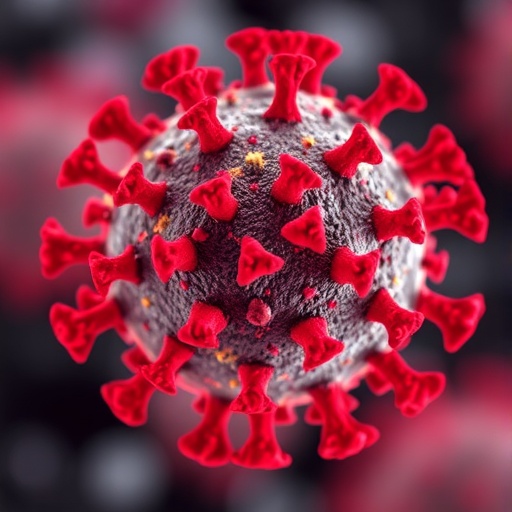
In the ongoing quest to understand the far-reaching effects of the COVID-19 pandemic, one of the most compelling yet complex areas of investigation has been the neurological and psychiatric sequelae following SARS-CoV-2 infection. A groundbreaking study recently published in Nature Communications provides a comprehensive analysis of the risk associated with a spectrum of neuropsychiatric conditions post-COVID-19, employing a sophisticated methodological framework that offers new clarity on this critical public health issue.
The study navigates through the intricate relationship between SARS-CoV-2 infection and its long-term impact on the brain and mental health. Leveraging a difference-in-differences analytic approach, renowned for its strength in causal inference from observational data, researchers meticulously compared the incidence of neuropsychiatric disorders in infected individuals versus matched controls. This method accounts for baseline temporal trends and unobserved confounding factors, thereby isolating the virus’s direct contribution to emerging neurological and psychiatric symptoms with unprecedented precision.
At the heart of this investigation lies a vast dataset encompassing millions of electronic health records across diverse healthcare settings. By integrating data from such a broad population base, the investigators ensured the inclusivity of various demographics, spanning age groups, genders, ethnic backgrounds, and comorbidities. This comprehensive approach allowed the study to capture subtle variations in risk that are often masked in smaller cohorts or less rigorously matched controls.
.adsslot_3Ei2VIA8r1{width:728px !important;height:90px !important;}
@media(max-width:1199px){ .adsslot_3Ei2VIA8r1{width:468px !important;height:60px !important;}
}
@media(max-width:767px){ .adsslot_3Ei2VIA8r1{width:320px !important;height:50px !important;}
}
ADVERTISEMENT
A striking outcome of the analysis revealed a significantly elevated risk for several neuropsychiatric conditions within six months following COVID-19 diagnosis. Among these, anxiety disorders and mood disturbances surfaced prominently, pointing to the profound psychological burden exerted by the virus. Additionally, the study identified increased incidences of cognitive impairments, including what is popularly termed “brain fog,” as well as cases of psychotic disorders, indicating a multifaceted impact on mental health.
Beyond psychological effects, the investigation delved into neurological manifestations that have been increasingly reported throughout the pandemic. The data highlighted notable surges in cerebrovascular events such as ischemic strokes and transient ischemic attacks, potentially linked to the prothrombotic state induced by SARS-CoV-2 infection. Moreover, peripheral neuropathies and other neurological sequelae were noted, suggesting widespread neuroinflammatory processes triggered by the virus.
Crucially, the temporal dynamics of these conditions were scrutinized, revealing that many neuropsychiatric risks peak within the first 30 to 90 days post-infection but persist markedly up to six months. This persistent risk profile underscores the necessity for continuous clinical vigilance and the development of targeted surveillance strategies to identify and manage sufferers early, potentially mitigating long-term disability.
The researchers also examined the interplay of age and severity of COVID-19 on subsequent neuropsychiatric outcomes. Older adults, as anticipated, exhibited heightened vulnerability, with more severe infections correlating with an augmented risk. However, alarmingly, even individuals with mild or asymptomatic infections faced elevated risks, challenging prior assumptions that only severe COVID-19 cases precipitate such complications.
One critical insight uncovered by the study relates to the potential mechanisms underpinning these neuropsychiatric sequelae. While direct viral invasion of the central nervous system remains a topic of ongoing debate, the data suggest that immune dysregulation, systemic inflammation, microvascular injury, and chronic stress responses may collectively orchestrate the observed neurological damage and psychological distress after infection.
Another facet of the research considered the confounding role of pandemic-related societal factors, such as lockdowns and economic upheaval, which complicate disentangling the virus’s direct effects from psychosocial stressors. The difference-in-differences framework adeptly adjusted for these variables by incorporating contemporaneous control groups, thereby strengthening the causal claims associating SARS-CoV-2 infection itself with the heightened neuropsychiatric burden.
Importantly, the study’s extensive representative sample allowed for stratified analyses by vaccination status and viral variants, although these aspects warrant deeper exploration in future research. Preliminary trends indicated that vaccination might attenuate the risk of post-infection neuropsychiatric complications, reiterating the broader protective benefits of immunization beyond merely preventing acute illness.
Complementing quantitative analyses, the authors discussed implications for healthcare systems globally, highlighting the urgent need to equip neuropsychiatric services to handle surges in demand potentially triggered by the pandemic’s downstream effects. They advocate for the establishment of multidisciplinary care pathways integrating neurology, psychiatry, and rehabilitation services to address the complex needs of COVID-19 survivors with long-term neuropsychiatric symptoms.
From a research perspective, this robust analytical framework sets a new benchmark for observational studies probing disease outcomes in real-world settings. By systematically controlling for temporal trends and confounders, the approach enables stakeholders to discern subtle but clinically meaningful associations with greater confidence, an imperative for guiding policy and clinical decision-making in the post-pandemic era.
In conclusion, this landmark study elucidates the considerable burden of neuropsychiatric conditions associated with SARS-CoV-2 infection. It calls attention to the silent yet serious consequences of the virus that extend well beyond acute respiratory illness, manifesting as a spectrum of mental and neurological health challenges. As the global community continues to grapple with the evolving pandemic landscape, these findings underscore the criticality of sustained surveillance, targeted interventions, and ongoing investigation into the pathophysiological underpinnings of COVID-19’s neurological impact.
Ultimately, understanding the aftermath of SARS-CoV-2 infection in terms of brain health is not only essential for individual patient care but also for public health planning and resource allocation. With millions worldwide affected, acknowledging and addressing the neurological and psychiatric dimensions of COVID-19 will be pivotal in shaping a holistic recovery narrative for humanity in the years to come.
Subject of Research: Risk of neuropsychiatric and related conditions associated with SARS-CoV-2 infection
Article Title: Risk of neuropsychiatric and related conditions associated with SARS-CoV-2 infection: a difference-in-differences analysis
Article References:
Lu, Y., Tong, J., Zhang, D. et al. Risk of neuropsychiatric and related conditions associated with SARS-CoV-2 infection: a difference-in-differences analysis. Nat Commun 16, 6829 (2025). https://doi.org/10.1038/s41467-025-61961-1
Image Credits: AI Generated
Tags: causal inference in observational studiescomprehensive analysis of neuropsychiatric conditionsdemographic variations in mental healthelectronic health records in researchlong-term effects of SARS-CoV-2 infectionmental health consequences of COVID-19methodological approaches in health researchneurological disorders post-COVIDneuropsychiatric risks of COVID-19pandemic impact on brain healthpublic health implications of COVID-19risk factors for psychiatric disorders





